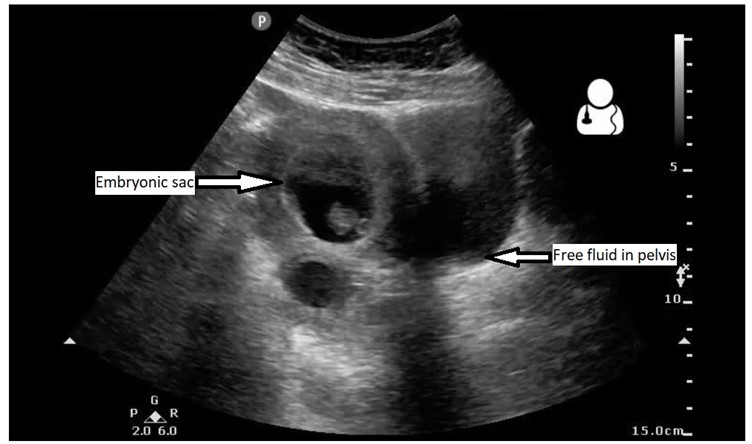Ultrasound of the Week #025

Published on behalf of Dr Salman Naeem, Ultrasound Fellow, RLH. Many thanks to him for compiling and submitting this case.
Case:
A 29 year old lady presumed 12/40 pregnant felt unwell and then collapsed in front of her children at home. The ambulance team arrived around 15 minutes later. She did not have by-stander CPR. The initial rhythm was PEA. She was given adrenaline and she then had episodes of ROSC and further arrest 8 times.
An echo done by advanced paramedic did not show right heart dilation.
She arrived in the department at an hour later and suddenly lost output again.
An abdominal US scan was done which showed intra-uterine pregnancy and free fluid in the pelvis (the original images of the patient were sadly lost, but these are images from other patients demonstrating the pathology)


The first image shows an embryonic sac in the uterus and the second image shows free fluid in the peritoneum.
The patient was given rapid transfusion of blood products and taken to theatre where the team could not find the source of bleeding and unfortunately, she died.
This is a sad yet very good case to learn about use and pitfalls of POCUS in cardiac arrest, early diagnosis / treatment of causes of cardiac arrest and thinking about differentials of intraperitoneal free-fluid in a pregnant female.
The common differentials for non-traumatic free fluid in a young female who is pregnant can be:
- Ectopic pregnancy
- Heterotopic pregnancy
- Ruptured hepatic hemangioma
- Corpus luteum rupture
- Ascites secondary to ovarian/cervical cancer or chronic liver disease
- Inflammatory fluid due enteritis or cholecystitis
- Abscess
In this case although we found an intrauterine pregnancy, that does not rule out a heterotopic ectopic pregnancy and as such, these patients will still need exploratory surgery if they are hypotensive. Heterotopic pregnancy is more common in females who are undergoing fertility treatment up to 1-3% of pregnancies1,2.
Another interesting finding was that in this patient the team was unable to find the cause of bleeding.
Hepatic haemangiomas are notorious for causing severe bleeding. Hepatic haemangiomas are the most common benign liver tumour with an incidence of over 7% and female to male ratio of 5:1. The incidence of bleeding from a hepatic haemangioma is about 4%. They are more prone to rupture in pregnancy and then notoriously may stop bleeding, hence often the diagnosis is made on post mortem.
POCUS in Undifferentiated Shock:
POCUS can help in diagnosis of some causes of cardiac arrest but a limited POCUS examination might miss the diagnosis. A Shock protol can assist in narrowing differentials in undifferentiated hypotension or cardiac arrest thought secondary to hypotension. There are many such protocols, an example of one of which is depicted below:

This patient bled from a spontaneously ruptured hepatic hemangioma which was confirmed on the post mortem report.
SUMMARY LEARNING POINTS:
- POCUS can help diagnose cause of cardiac arrest and expedite management, however one should follow the whole algorithm otherwise we risk missing the pathology. The link for SHoC scan is below
- Finding of intra-uterine pregnancy does not rule out heterotopic ectopic pregnancy in pregnant patient with free fluid in the abdomen.
- Think about other causes of free fluid in the abdomen including ruptured hepatic hemangiomas and inflammatory fluid in the absence of trauma.
References:
- Kirk E, Bottomley C, Bourne T. Diagnosing ectopic pregnancy and current concepts in the management of pregnancy of unknown location. Hum Reprod Update. 2014 Mar-Apr;20(2):250-61. doi: 10.1093/humupd/dmt047. Epub 2013 Oct 6. PMID: 24101604.
- https://journals.lww.com/md-journal/fulltext/2017/02240/Rupture_of_hepatic_hemangioma_with_hemoperitoneum.10.aspx
- Bajenaru N, Balaban V, Săvulescu F, Campeanu I, Patrascu T. Hepatic hemangioma -review-. J Med Life. 2015;8 Spec Issue(Spec Issue):4-11.
- Atkinson P, et al International Federation for Emergency Medicine Consensus Statement: Sonography in hypotension and cardiac arrest (SHoC): An international consensus on the use of point of care ultrasound for undifferentiated hypotension and during cardiac arrest. CJEM. 2017 Nov;19(6):459-470. doi: 10.1017/cem.2016.394. Epub 2016 Dec 21. Erratum in: CJEM. 2017 Jul;19(4):327. PMID: 27998322.
- Ke QH, Zhang CJ, Huang HF. Rupture of hepatic hemangioma with hemoperitoneum due to spontaneous gallbladder perforation: A unique case report. Medicine (Baltimore). 2017 Feb;96(8):e6110. doi: 10.1097/MD.0000000000006110. PMID: 28225491; PMCID: PMC5569422.
- https://en.wikipedia.org/wiki/Heterotopic_pregnancy





